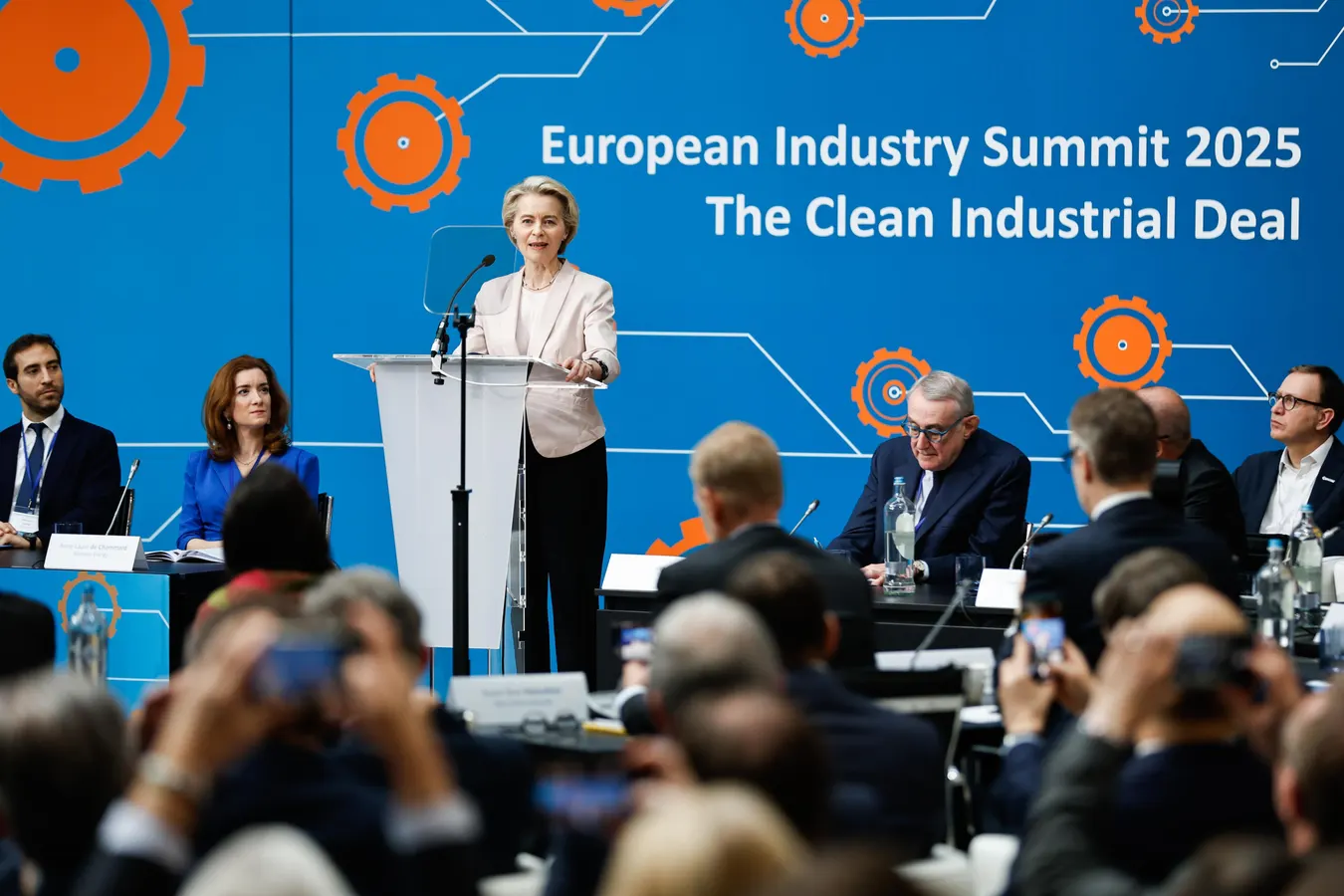Copyright forbes

Ursula von der Leyen, president of the European Commission, delivers a speech during a meeting with business leaders following the unveiling of the 'Clean Industrial Deal', in Antwerp, Belgium, on Wednesday, Feb. 26, 2025. The European Union unveiled a plan that preserves its ambitious climate goals while trying to improve industrial competitiveness in the face of increasing rivalry from the US and China. Photographer: Simon Wohlfahrt/Bloomberg © 2025 Bloomberg Finance LP European leaders want to simplify sustainability rules. Yet investors and insurers are already reflecting climate risk in financing and coverage decisions. As the politics of competitiveness collide with the economics of climate exposure, resilience is shifting from a corporate aspiration to a financial reality, one that’s reshaping markets, margins and balance sheets alike. Brussels Policy Reversal Tests Europe’s Competitiveness Over the past year, the European Commission’s “competitiveness and simplification” drive has targeted the core of the EU’s sustainability architecture: the Corporate Sustainability Reporting Directive (CSRD) and the Corporate Sustainability Due Diligence Directive (CSDDD). The Omnibus I package proposed higher company-size thresholds, narrower value-chain duties, and removal of the civil-liability provisions that allowed victims to seek damages for human-rights or environmental harms. That deregulatory push just met its first major setback. The European Parliament rejected the JURI Committee’s Omnibus I mandate, sending the proposal back for renegotiation. Richard Gardiner, interim head of EU policy at ShareAction, said the vote “shows that attempts to force through deregulation without genuine compromise or consultation have failed.” He added that Europe’s sustainability framework “cannot be rewritten through political coercion or back-room manoeuvres” and welcomed President Metsola’s call for a return to “evidence-based policymaking and a broad, centrist majority.” The episode exposes the fault line between calls for “simplification” and the need for predictable, decision-useful data. For investors, that data underpins trillions in capital allocation; for politicians, it has become a proxy battle over competitiveness. Harald Heubaum, director of the Centre for Energy and Climate Policy at SOAS, told me the setback reflects “a deeper struggle over Europe’s identity as a rules-based market.” He added that “simplification may sound technical, but it’s really about whether Europe competes on credibility or on shortcuts.” MORE FOR YOU Geopolitics, Not Just Green Rules While Brussels argues over paperwork, businesses on the ground face overlapping shocks, from trade disruption to climate-driven losses. Ramya Ravishankar, general counsel at HowGood, cautions that the EU’s recalibration “needs to be taken in totality with other geopolitical forces at play,” citing U.S. tariff policies and conflicts in Ukraine and the Middle East. “The Omnibus proposal represents an effort by European markets to maintain competitiveness with the United States and to strengthen transatlantic cooperation amid this period of uncertainty,” she said. “However, the issues our world is facing are serious, and there are clear indicators that major brands still see sustainability as a business advantage, not a burden. Transparency in reporting supported by granular data is critical to bridge the gap between politicians and the problems people are constantly facing today.” Her point highlights the real economy beneath the rhetoric: climate shocks, fragile supply chains, and consumers who still reward credible purpose. The politics of simplification may soothe headlines, but the economics of climate reality are already shaping prices, production, and demand. Europe Holds The Line For Now On October 21, the European Commission moved to safeguard another pillar of the Green Deal: the EU Deforestation Regulation (EUDR). The proposal eases obligations for micro- and small-enterprises, delaying their compliance until December 2026, but keeps the main deforestation-free requirements and cutoff date for larger firms. Stientje van Veldhoven, vice president and regional director for Europe at the World Resources Institute, called the compromise a “workaround” that allows enforcement to begin as planned. “While no tampering would have been preferable, this approach is far better than delaying enforcement another year or gutting the regulation,” she said. “The Commission appears focused on reducing burdens where the impact is small, while maintaining rigor where the stakes are high.” Together, the Parliament’s vote and the EUDR package suggest that Europe’s deregulatory tide is not a full retreat, at least not yet. Markets and Insurers Put a Price on Climate Risk Financial markets are already doing what politics won’t – enforcing climate discipline through price. Analysis from Bloomberg Intelligence found that a 10-point increase in projected climate-damage exposure to a company’s assets corresponds to a 22-basis-point rise in its cost of capital. The penalty climbs to 94 bps in Latin America and 25 bps in Asia, and is most severe in materials and utilities, where exposure to floods and heat is high. Insurers are reporting a similar pattern. “Some risks remain technically insurable,” Rowan Douglas, chief executive of Climate Risk and Resilience at Howden told me, “but they’re increasingly unaffordable without subsidies or public backing.” It’s important to make a distinction between insurability and affordability for affected communities and businesses. Some risks may be high but remain insurable, though be too costly to bear without subsidies or other support. Douglas says, “We are seeing clear signs that certain regions and sectors are nearing the limits of affordability.” He notes that European agriculture already faces annual climate losses of €28 billion, projected to reach €40 billion by 2050 — much of it uninsured and creating a protection gap that threatens food security and rural economies. Douglas explains, “Ultimately, the losses fall on someone: property owners, insurers or the State and as losses grow the State can often takes a larger proportion of these unplanned, unbudgeted contingent liabilities in the face of political pressures. This produces short term fiscal stresses and burdens. In the longer term, insurability concerns may provoke liquidity and valuation risks. This could lead to stranded assets and distressed regions and may represent a greater threat to financial stability in the years ahead. For these reasons, insurance and insurability is becoming a growing concern for financial regulators and policy makers.” “Insurability is becoming a forward-looking indicator of financial health,” Douglas added. “When it erodes, so does access to capital.” In that sense, both capital and insurance markets are already pricing resilience — rewarding firms and sectors that invest in adaptation and penalising those that don’t. Financing is more expensive for vulnerable firms; insurance is scarcer and pricier for exposed regions. That means that investors ignoring climate risk are mispricing portfolios. Companies that demonstrate resilience and adaptation, through disclosure, planning, or credible transition strategies, can lower both borrowing and coverage costs. What began as a weather problem is now a balance-sheet one. Policy Certainty, Not Rollback, Unlocks Industrial Investment A new report from the Industrial Transition Accelerator (ITA) and think tank E3G argues that Europe’s competitiveness problem will not be solved by deregulation but by creating lead markets for clean materials and chemicals. The analysis finds that fossil-based production is already more expensive than global averages, and that switching to low-carbon steel, aluminium, or cement would add only marginally to end-product costs, around 1–2% over many years. Faustine Delasalle, executive director of the ITA, said the findings show that, “European policymakers have a choice to make between unlocking investments that will strengthen their competitive advantage in clean industry, or clinging to a vulnerable and struggling fossil-based industry and falling further behind.” The report estimates that clear, targeted policies to stimulate demand for clean products could unlock more than €100 billion in investment and re-establish Europe’s lead in industrial innovation. Johanna Lehne, associate director, clean economy at E3G was clear, saying “the costs of going green are far lower than the costs of standing still.” The message reinforces what investors and insurers are already signalling: policy certainty and demand creation, not deregulation, are the true drivers of competitiveness. The Credibility Premium Taken together, these signals reveal a widening gap between political cycles and market logic. While lawmakers debate easing compliance, investors and insurers continue to price climate risk with increasing precision. Europe’s edge has never been speed or cheap capital, but credibility, trusted sustainability data, consistent definitions, and rule-based governance that gave investors confidence in what they were financing. Diluting that system now risks eroding one of the few advantages that still sets Europe apart in global markets. Simplifying for political convenience may buy time, but it also risks eroding the informational infrastructure that keeps capital flowing at scale. The same physics that flood a field or idle a factory are now reshaping balance sheets. Markets no longer need to be convinced that climate risk is real, they’re accounting for it. That is why a growing number of investors describe adaptation as alpha: resilience, not rhetoric, drives performance. Policymakers can debate the pace of regulation, but the cost of inaction is already being priced in. For true competitiveness, policy should follow suit. Editorial StandardsReprints & Permissions



